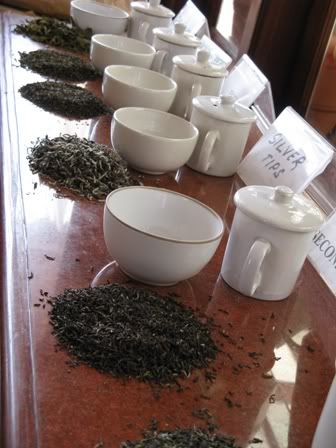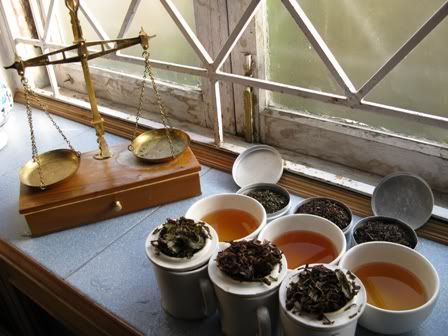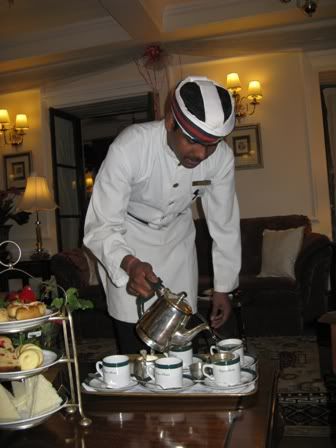Just been thinking... Japan is famous for chawan, kyusu, and tetsubin. China is famous for Yixing pots, gaiwan, and of course fine china. Russia has the samovar. Even South America has the mate gourd and straw.
What's India's contribution to traditional teaware? Surely there must be something I'm forgetting? I know India is a former British Colony, so I'm sure there is a lot of overlap with British teaware. Did what we commonly think of as "British-style" teaware (ceramic and porcelain side-handled pots and cups, silver pots, etc,) originate in India then work it's way west?
I'm sure a country with so much tea tradition must have unique styles of pots or cups, but I just don't know the history. Please educate me!
Re: Traditional teaware from India?
It was the British who brought tea industry to India. They were depending on China for their tea supplies and wanted to gain more control of the production of their favourite beverage. There were actually British spies who sneaked to China to learn the secrets of tea farming , roasting etc. After they got the necessary information, the British founded tea plantations in India (causing lot of suffering for locals who were forced to make hard labor in jungles). So I think it originally went like this: British teaware was introduced to India and not the other way round. India has since then developed its own rich chai-culture, but I don't think they use very elaborate teaware for chai. Chai is made in kettles/pans and served in simple glasses like these: http://chai-wallah.com/buychai/store.ph ... how_detail
Re: Traditional teaware from India?
I was in Darjeeling in Feb this year to visit the tea estates there as well as speak to people involved in the tea trade.
In almost every hotel and home I went, tea was served in porcelain, reflecting a strong British influence.
At tea tasting sessions with tea estate managers and tea consultants, it is white clay or porcelain cups.
At a tea boutique in Darjeeling

Teaware at a tea tasting session held at a tea consultant's home

Tea Service at Elgin Hotel, Darjeeling

Wife of a tea estate manager making tea for us using her best china. Took place on a lovely morning in her beautiful garden after her morning exercise.

Ahh...these pictures bring back such good memories!!!!!
In almost every hotel and home I went, tea was served in porcelain, reflecting a strong British influence.
At tea tasting sessions with tea estate managers and tea consultants, it is white clay or porcelain cups.
At a tea boutique in Darjeeling

Teaware at a tea tasting session held at a tea consultant's home

Tea Service at Elgin Hotel, Darjeeling

Wife of a tea estate manager making tea for us using her best china. Took place on a lovely morning in her beautiful garden after her morning exercise.

Ahh...these pictures bring back such good memories!!!!!
Re: Traditional teaware from India?
Compared to China and Japan, there is no tea culture in India. Although tea is grown in places like Darjeeling and Kerala, and, from what I hear, some very good teas hail from there, few people know anything about tea or are interested in teas aside from the grower culture and maybe some elite class tea drinkers who aspire to be more worldly. Other than that, it's milky tea in glasses, and, in poorer neighborhoods, brass cups. Both, with lots of sugar. Hmm, so much subtlety in flavor and aroma with milk and shugaaah! Om Namah Siva Ya.tingjunkie wrote:Just been thinking... Japan is famous for chawan, kyusu, and tetsubin. China is famous for Yixing pots, gaiwan, and of course fine china. Russia has the samovar. Even South America has the mate gourd and straw.
What's India's contribution to traditional teaware? Surely there must be something I'm forgetting? I know India is a former British Colony, so I'm sure there is a lot of overlap with British teaware. Did what we commonly think of as "British-style" teaware (ceramic and porcelain side-handled pots and cups, silver pots, etc,) originate in India then work it's way west?
I'm sure a country with so much tea tradition must have unique styles of pots or cups, but I just don't know the history. Please educate me!
Aug 21st, '09, 09:49
Posts: 20891
Joined: Apr 22nd, '06, 20:52
Scrolling: scrolling
Location: Back in the TeaCave atop Mt. Fuji
Re: Traditional teaware from India?
"Hot Tea," thanks for sharing your journey in pictures with us!!!
I think this puts it into proper perspective. The best teas in China and Japan never leave the country of origin, often reserved for highest officials in the land.
The best teas of India are sold mostly for export.
I think that says a lot. For India, it is simply an export commodity, not to say Indians do not like tea, but it is not such a part of their culture or even religion like China or Japan. But for India, it was a foreign introduction never really intended for local consumption.
But they do produce some fantastic teas ...
I think this puts it into proper perspective. The best teas in China and Japan never leave the country of origin, often reserved for highest officials in the land.
The best teas of India are sold mostly for export.
I think that says a lot. For India, it is simply an export commodity, not to say Indians do not like tea, but it is not such a part of their culture or even religion like China or Japan. But for India, it was a foreign introduction never really intended for local consumption.
But they do produce some fantastic teas ...
Re: Traditional teaware from India?
+1 The Mod and I occasionally do enjoy some of those fantastic teas.Chip wrote:"Hot Tea," thanks for sharing your journey in pictures with us!!!
I think this puts it into proper perspective. The best teas in China and Japan never leave the country of origin, often reserved for highest officials in the land.
But they do produce some fantastic teas ...
Very nice photos, Thanks.
And a tardy Welcome to TeaChat! Hope you continue to share with us.
.
Re: Traditional teaware from India?
Thank you all for the great info!
I had always assumed tea culture had spread west from China over the Silk/Spice Roads and had ended up in India that way. Interesting that it actually came from Britain to back east.
Since we are on the topic, anyone have a favorite book which chronicles the history of tea? I have a book or two, but they only cover the topic lightly.
I had always assumed tea culture had spread west from China over the Silk/Spice Roads and had ended up in India that way. Interesting that it actually came from Britain to back east.
Since we are on the topic, anyone have a favorite book which chronicles the history of tea? I have a book or two, but they only cover the topic lightly.
Re: Traditional teaware from India?
I think of Indian teaware as the clay cups that they use for Chai.
tingjunkie, one good book is 'The Story of Tea' by Mary Lou and Robert Heiss. They cover the different kinds of tea as well as growing areas.
tingjunkie, one good book is 'The Story of Tea' by Mary Lou and Robert Heiss. They cover the different kinds of tea as well as growing areas.
Re: Traditional teaware from India?
Chip wrote: For India, it is simply an export commodity, [...] But for India, it was a foreign introduction never really intended for local consumption.
Chip, it's true that the best Indian teas are meant for export, it's not true that tea is not consumed by locals. They have it for breakfast as well as during the day. Wherever you go you are offered chai, you can even buy your cup on the trains.
True, tea has not entered Indian culture or religion, and Indians do not seem to be very picky about the tea they use for chai.
Re: Traditional teaware from India?
The Tea Muse, August 2000 Issue:
The Origins of Indian Tea.
http://www.teamuse.com/article_000803.html
History of tea culture in Sri Lanka:
http://en.wikipedia.org/wiki/Tea_produc ... _Sri_Lanka
http://www.gol27.com/HistoryTeaCeylon.html
But no, the English weren't entirely responsible for the introduction of 'tea culture' to India. It existed for thousands of years prior to British Raj, although the Brits established modern production in India and Ceylon (the import of workers from S India to Ceylon for the coffee and tea plantations was fueled ethnic strife much later, another interesting story):
http://en.wikipedia.org/wiki/Indian_tea_culture
"Today, India is one of the largest tea producers in the world, though over 70% of the tea is consumed within India itself. "
The issue of India's domestic consumption quality is quite interesting. In the early 1990s, domestic tea consumption in India threatened the important tea export markets, forcing import from Ceylon and cultivation of CTC teas elsewhere - Africa, Indochina peninsula and Indonesia (primarily Sumatra and Java).
Interestingly, the AssamTeaExchange website suggesting that it originated via the Silk Road Trade Route, although ancient use of tea as a vegetable and soup was documented in ancient (4-5,000 yo) texts in India, which roughly parallels establishment of trade routes between India and China.
http://www.assamteaxchange.com/abouttea/history.asp
http://en.wikipedia.org/wiki/Silk_Road#Prehistory
The AssamTeaBoard pagees do offer a rationale for chai tea culture: the expense and difficulty of tea access by the lower Indian social classes during the Colonial Era. Boiling low-grade tea (dust, stems) in milk and spices to make chai was one way to make the tea more flavorful, at least according to the ATE website.
However, chai is purported to be an ancient beverage, of medicinal (ayurveda) origin in India:
http://www.mytchai.com/index.php?option ... &Itemid=56
I think this explanation is highly plausible; the spices used in chai have outstanding ORAC (measure of antioxidant potency). The modern adaptation of chai using inexpensive (and harsh) CTC teas is probably a cultural adaptation of a much older medicinal tea-drinking habit.
Why the milk? Well, it's an excellent emulsifier of spice oils; the sugar cuts the bitter taste of boiled tea leaves and spices.
As an antiviral/antibacterial strategy, heavily spiced chai with it's high ORAC and micromineral content may well be superior to consuming plain tea, regardless of it's pedigree.
The Origins of Indian Tea.
http://www.teamuse.com/article_000803.html
History of tea culture in Sri Lanka:
http://en.wikipedia.org/wiki/Tea_produc ... _Sri_Lanka
http://www.gol27.com/HistoryTeaCeylon.html
But no, the English weren't entirely responsible for the introduction of 'tea culture' to India. It existed for thousands of years prior to British Raj, although the Brits established modern production in India and Ceylon (the import of workers from S India to Ceylon for the coffee and tea plantations was fueled ethnic strife much later, another interesting story):
http://en.wikipedia.org/wiki/Indian_tea_culture
"Today, India is one of the largest tea producers in the world, though over 70% of the tea is consumed within India itself. "
The issue of India's domestic consumption quality is quite interesting. In the early 1990s, domestic tea consumption in India threatened the important tea export markets, forcing import from Ceylon and cultivation of CTC teas elsewhere - Africa, Indochina peninsula and Indonesia (primarily Sumatra and Java).
Interestingly, the AssamTeaExchange website suggesting that it originated via the Silk Road Trade Route, although ancient use of tea as a vegetable and soup was documented in ancient (4-5,000 yo) texts in India, which roughly parallels establishment of trade routes between India and China.
http://www.assamteaxchange.com/abouttea/history.asp
http://en.wikipedia.org/wiki/Silk_Road#Prehistory
The AssamTeaBoard pagees do offer a rationale for chai tea culture: the expense and difficulty of tea access by the lower Indian social classes during the Colonial Era. Boiling low-grade tea (dust, stems) in milk and spices to make chai was one way to make the tea more flavorful, at least according to the ATE website.
However, chai is purported to be an ancient beverage, of medicinal (ayurveda) origin in India:
http://www.mytchai.com/index.php?option ... &Itemid=56
I think this explanation is highly plausible; the spices used in chai have outstanding ORAC (measure of antioxidant potency). The modern adaptation of chai using inexpensive (and harsh) CTC teas is probably a cultural adaptation of a much older medicinal tea-drinking habit.
Why the milk? Well, it's an excellent emulsifier of spice oils; the sugar cuts the bitter taste of boiled tea leaves and spices.
As an antiviral/antibacterial strategy, heavily spiced chai with it's high ORAC and micromineral content may well be superior to consuming plain tea, regardless of it's pedigree.
Aug 31st, '09, 13:23
Vendor Member
Posts: 1990
Joined: Apr 4th, '06, 15:07
Location: NYC
Contact:
TIM
Re: Traditional teaware from India?
If Siddhartha Gautama (aka Buddha) got enlightenment in 400 BC. Then tea culture in India is almost as ancient as China?
Aug 31st, '09, 15:09
Posts: 20891
Joined: Apr 22nd, '06, 20:52
Scrolling: scrolling
Location: Back in the TeaCave atop Mt. Fuji
Re: Traditional teaware from India?
Yes, I am aware that tea is consumed by locals. Of course locals once they tried tea, they would certainly want tea for their consumption as well.Jayaratna wrote:Chip, it's true that the best Indian teas are meant for export, it's not true that tea is not consumed by locals.Chip wrote: For India, it is simply an export commodity, [...] But for India, it was a foreign introduction never really intended for local consumption.
Re: Traditional teaware from India?
I hesitated in use of the term the medicinal an dietary (vegetable) use of tea as true 'tea culture', beverage consumption...but after looking over historical maritime spice routes and southern overland trade routes that linked Africa and Western-SouthCentral-SE China
(for the former, see http://asiapacificuniverse.com/pkm/spiceroutes.htm)
at about the time period we're discussing, it seems logical that traders and medicine/herb purveyors would recognize tea bushes in Bengal and Yunnan.
Could tea have been traded as a spice/herb along these trade routes more than 3000 years ago? Maybe there was trade in the dried leaves within each region, maybe the use of local (tea) herbs and those from abroad were used in various mixtures in villages as cultural knowledge of ethnobotany spread throughout Asia with trade and religion.
http://chestofbooks.com/health/aromathe ... y-And.html
"During the prime of the Babylonian empire, about 2000 to 1000 B. C, a lively caravan trade was developed which extended from China, India and Arabia to Egypt, Palestine, Syria, and the Black sea."
Use of aromatic oils and spices for medicine and as seasoning and preservatives moved along these trade routes, so it appears at least possible that ancient tea leaf use in India dated to approximately the same time as it spread within China, where medicinal use included drying and preserving of leaves for preparing tissanes- teas - for curing various maladies.
Edit: almost forgot to add the reason why tea as medicine would become popular in local pharmacopoeia use: it's a known antidote for more than 70 poisonous herbs (see: http://en.wikipedia.org/wiki/Shennong, section entitled, 'In popular culture').
(for the former, see http://asiapacificuniverse.com/pkm/spiceroutes.htm)
at about the time period we're discussing, it seems logical that traders and medicine/herb purveyors would recognize tea bushes in Bengal and Yunnan.
Could tea have been traded as a spice/herb along these trade routes more than 3000 years ago? Maybe there was trade in the dried leaves within each region, maybe the use of local (tea) herbs and those from abroad were used in various mixtures in villages as cultural knowledge of ethnobotany spread throughout Asia with trade and religion.
http://chestofbooks.com/health/aromathe ... y-And.html
"During the prime of the Babylonian empire, about 2000 to 1000 B. C, a lively caravan trade was developed which extended from China, India and Arabia to Egypt, Palestine, Syria, and the Black sea."
Use of aromatic oils and spices for medicine and as seasoning and preservatives moved along these trade routes, so it appears at least possible that ancient tea leaf use in India dated to approximately the same time as it spread within China, where medicinal use included drying and preserving of leaves for preparing tissanes- teas - for curing various maladies.
Edit: almost forgot to add the reason why tea as medicine would become popular in local pharmacopoeia use: it's a known antidote for more than 70 poisonous herbs (see: http://en.wikipedia.org/wiki/Shennong, section entitled, 'In popular culture').
Last edited by Intuit on Aug 31st, '09, 18:09, edited 1 time in total.
Re: Traditional teaware from India?
Apart from the use of very fine china/porcelain teaware in the increasingly prosperous subcontinent urban centers, India's metal craftsmen are among the most talented in the world, specializing in the production and export of high-quality sterling, silver-plate and pewter tea and coffee service sets.
India also produces glass teaware in abundance for domestic and export trade.
India also produces glass teaware in abundance for domestic and export trade.
Aug 31st, '09, 18:33
Posts: 2299
Joined: Oct 23rd, '06, 19:46
Location: Seattle Area
Contact:
tenuki
Re: Traditional teaware from India?
google 'chai walla' - Chai stands are all over the place , but the cheap red lowfired clay teaware that it's served in is traditionally expendable, ie you get it with your drink and throw it out when you are done.
btw - I have a set like Ritva linked to, much fun when guests are about and I numb all of their tounges with some Tao of Tea 500 mile cha supplemented with fresh ginger.
btw - I have a set like Ritva linked to, much fun when guests are about and I numb all of their tounges with some Tao of Tea 500 mile cha supplemented with fresh ginger.